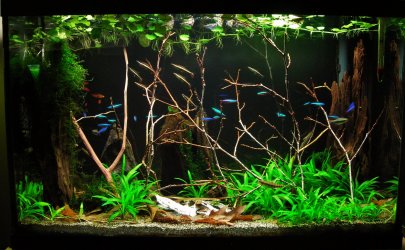Hi everyone. I've been all over the Internets, but sometimes just posting to see what real people respond helps the best (and also steer me clear of any bad information...bad information on the internet? No way...) Also went by a fish store, but want to make sure they're not trying to take advantage of my ignorance.
Thanks in advance to any and all help! I will definately take it to heart. This is a tank I'm getting for my work in my office, I have a SE corner cube, but a building across the street blocks most of the sunlight from the east and the south windows wouldn't bring direct sunlight to where I'm putting the tank.
1) Aquarium. The store recommended and seems good to get the Aqueon kit. I'm debating between the 20 gallon and 29 gallon.
20 Gallon seems cool with the contemporary top and such, but will need a heater added; also like the black background:
https://www.aqueon.com/products/aquarium-starter-kits/ascent-frameless-led-kits
29 Gallon seems like it'd be more forgiving to my newness.
https://www.aqueon.com/products/aquarium-starter-kits/rectangle-deluxe-led-kits
2a) Fish! The stars of the tank - I know a lot will depend on if I get a 20 or 29 gallon, but after a lot of thought, I think it'd be really nice to have a Blue Ram Chichlid and a Betta. I've seen things saying they get along fine with enough space and others say never do it. Thoughts?
2b) Supporting cast of the tank - I would love to add some shrimp, Kuhlii loaches, and maybe snails? Also a dwarf frog would be cool. Finally I know I'll need some schooling fish to help make the Ram Chichlid feel safer. Any suggestions? Tetras? Rasboas? Not really sure yet. I think I'd want to avoid any live-bearers as I don't want to worry about babies.
3) Sand? I think sand would be cool...any objections?
4) Plants - I'd like some live plants. Do I get those right away or wait until the aquarium cycles first?
I am VERY open to critism. I am new and very willing to learn.
Thanks in advance to any and all help! I will definately take it to heart. This is a tank I'm getting for my work in my office, I have a SE corner cube, but a building across the street blocks most of the sunlight from the east and the south windows wouldn't bring direct sunlight to where I'm putting the tank.
1) Aquarium. The store recommended and seems good to get the Aqueon kit. I'm debating between the 20 gallon and 29 gallon.
20 Gallon seems cool with the contemporary top and such, but will need a heater added; also like the black background:
https://www.aqueon.com/products/aquarium-starter-kits/ascent-frameless-led-kits
29 Gallon seems like it'd be more forgiving to my newness.
https://www.aqueon.com/products/aquarium-starter-kits/rectangle-deluxe-led-kits
2a) Fish! The stars of the tank - I know a lot will depend on if I get a 20 or 29 gallon, but after a lot of thought, I think it'd be really nice to have a Blue Ram Chichlid and a Betta. I've seen things saying they get along fine with enough space and others say never do it. Thoughts?
2b) Supporting cast of the tank - I would love to add some shrimp, Kuhlii loaches, and maybe snails? Also a dwarf frog would be cool. Finally I know I'll need some schooling fish to help make the Ram Chichlid feel safer. Any suggestions? Tetras? Rasboas? Not really sure yet. I think I'd want to avoid any live-bearers as I don't want to worry about babies.
3) Sand? I think sand would be cool...any objections?
4) Plants - I'd like some live plants. Do I get those right away or wait until the aquarium cycles first?
I am VERY open to critism. I am new and very willing to learn.




